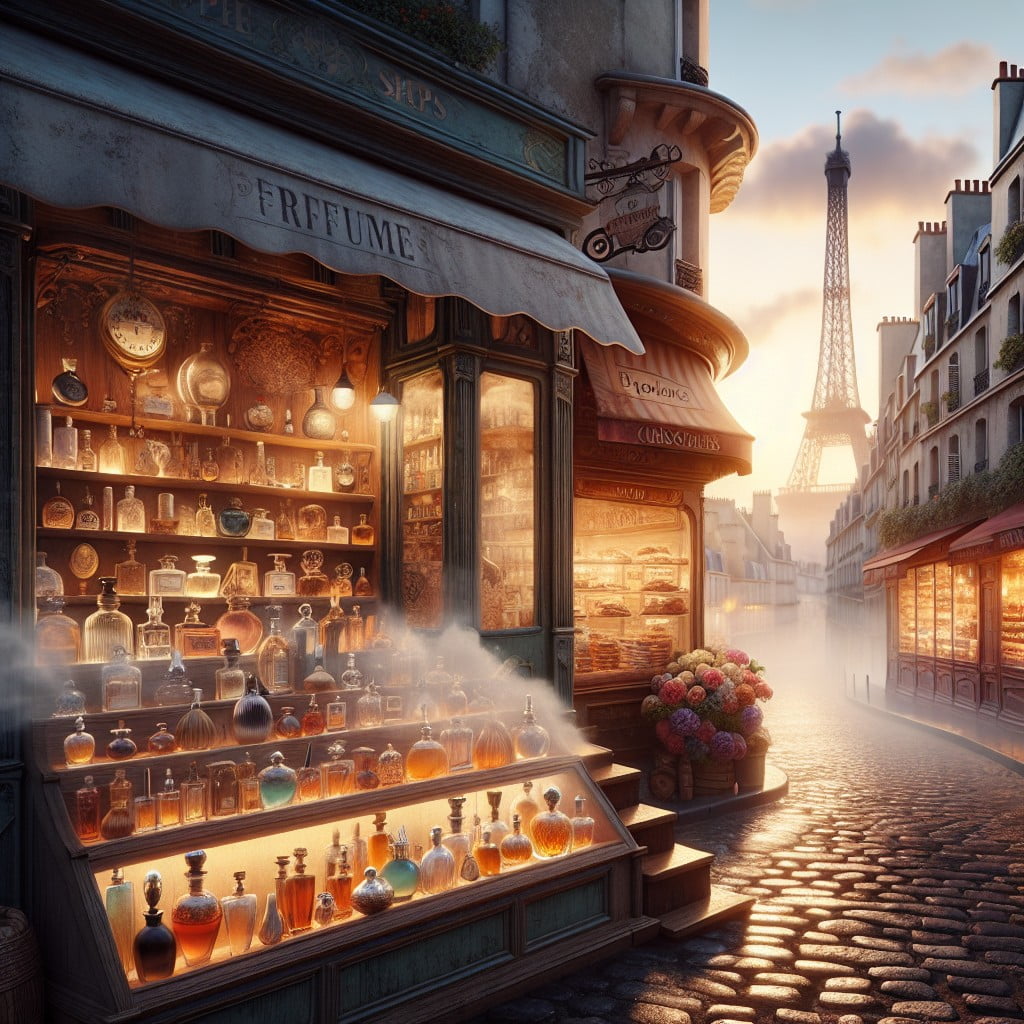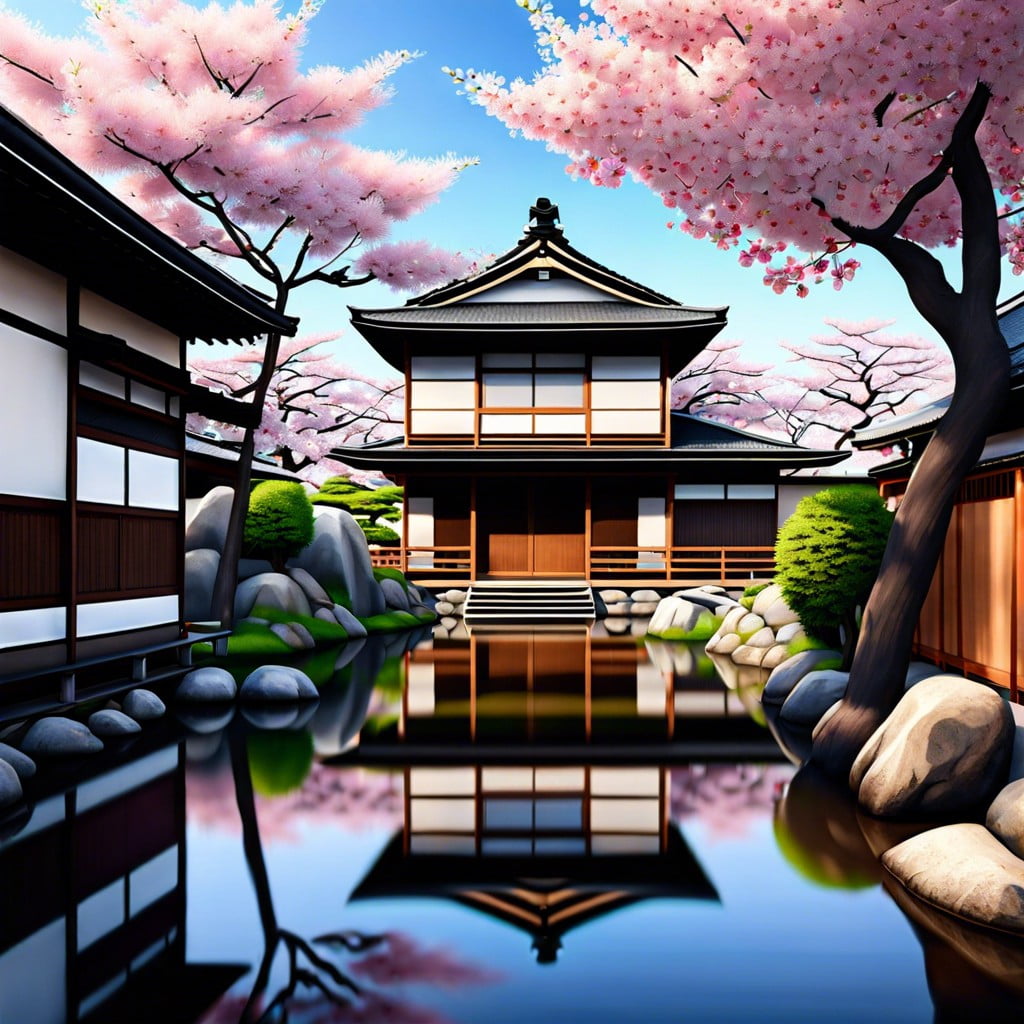Dive into the intoxicating world of Parisian perfumes as we unlock the mysteries of their allure, because every scent tells a mesmerizing story waiting to be unraveled.
Key takeaways:
- Paris scents deeply rooted in city’s rich history
- Perfumery influenced by historical figures like Napoleon Bonaparte
- Artisanal craft of perfumery in Paris is meticulous and precise
- Iconic perfumeries and boutiques in Paris offer unique fragrances
- Parisian perfumers use exotic ingredients to create complex bouquets
Historical Influence On Paris Scents

The allure of Paris scents is deeply rooted in the city’s rich history, which has profoundly shaped its olfactory landscape. During the reign of Louis XIV, known as the “perfumed court,” the use of fragrances was pivotal in masking the odors of less sanitary living conditions, as well as signifying one’s status and sophistication. This period marked the elevation of perfumery as an art form, leading to increased innovation in fragrance creation.
By the 18th century, the Grasse region, with its profusion of flowers, became a cornerstone for raw materials, ultimately being deemed the world’s capital of perfume. This synergy between Paris and Grasse solidified France’s position at the forefront of the perfume industry, a standing that it maintains to this day.
The influence of historical French figures also cannot be understated. For instance, Napoleon Bonaparte’s affinity for Eau de Cologne led to its widespread popularity, which then influenced the offerings of Parisian perfumers who sought to cater to these evolving preferences.
Move forward into the 20th century, the iconic Coco Chanel released Chanel No. 5, a reflection of the era’s liberation and an embodiment of Parisian elegance. Her insistence on simplicity and sophistication in a bottle revolutionized women’s fragrances, steering away from the heavy, complex scents that had been popular before.
The emphasis on luxury and craftsmanship, hallmarks of French heritage, remains a guiding principle in Parisian scent creation. The city’s storied past, with its seamless blend of opulence, artistry, and romance, continues to infuse the scents emanating from its legendary boulevards and ateliers.
Significance of Olfactory Sensations in Parisian Culture

Parisian life is intricately interwoven with a keen appreciation of the senses, where fragrance plays a significant role in daily rituals and social customs. This refined sensibility towards smell speaks to a broader French heritage celebrated for its culinary expertise, wine-making traditions, and floral abundance, all of which are industries reliant on the curation of complex aromas.
Walking through Paris, one might encounter the bouquet of fresh pastries intermingling with the scent of blooming gardens and the subtle perfumery notes escaping boutiques, culminating in an atmospheric symphony unique to the city. In personal adornment, Parisians often select fragrances that embody their identity or aspirational self, using scent as both personal signature and olfactory narrative.
The result is that in Paris, perfume is not just an accessory; it’s considered an essential extension of fashion and culture, an art form with the power to evoke emotion, memory, and a sense of place.
The Artisanal Craft of Perfumery in Paris
Delving into the Parisian perfumery’s artisanal craft reveals a meticulous process steeped in tradition and precision. Master perfumers, often referred to as “noses,” spend years honing their craft and developing their olfactory palette to create complex fragrances. These experts painstakingly blend natural essences and synthetic molecules to evoke emotions, memories, and a sense of place.
The use of hand-extracted oils and time-honored infusion techniques ensures that each scent is unique and tells a story. Perfume houses often guard their recipes as closely as top chefs protect their signature dishes. This dedication to excellence is evident in the care taken from sourcing ingredients to perfecting the final product.
The result of this craftsmanship is more than a fragrance—it’s an aromatic expression of artistry, heritage, and the Parisian elegance that resonates with perfume aficionados around the world.
Iconic Parisian Perfumeries and Boutiques
The cobblestone streets of Paris host an array of storied perfumeries and boutiques, each with its unique heritage and olfactory offerings.
Guerlain, nestled on the Champs-Élysées since 1828, stands as a testament to long-standing perfume artistry. It’s known for classics like ‘Shalimar’ and ‘Mitsouko’, offering personalized fragrance consultations.
Serge Lutens’ boutique in Palais Royal is a contemporary haven for fragrance connoisseurs, echoing the creator’s avant-garde approach with scents such as ‘Ambre Sultan’.
Annick Goutal, now a global brand started on Rue de Bellechasse, epitomizes the romantic spirit of Paris through whimsical fragrances including ‘Eau d’Hadrien’.
Maison Francis Kurkdjian, founded by one of the most acclaimed contemporary noses, draws aficionados to its boutique on Rue des Francs Bourgeois, where scents like ‘Baccarat Rouge 540’ signify modern luxury.
Le Labo, although not originally French, has solidified its presence with a boutique in Le Marais, offering a laboratory-style customization experience and cult favorites like ‘Santal 33’.
These perfumeries not only sell scents but also embody the Parisian flair for blending tradition with innovation, creating aromatic experiences that are both timeless and contemporary.
The Role of PRACAXI OIL in Parisian Fragrances
Pracaxi oil, derived from the seeds of the Pentaclethra macroloba tree native to the Amazon region, has emerged as a unique ingredient in Parisian perfumery. Its inherent properties offer a dual benefit: enhancing the sensory profile of a fragrance and providing skin-nourishing effects.
This oil’s silky texture allows for a smooth application, while its hydrating qualities extend the perfume’s longevity on the skin. Renowned for its high concentration of behenic acid, pracaxi oil imbues scents with a subtle, earthy dimension that pairs well with floral and citrus notes, creating a multifaceted olfactory experience.
Its inclusion in formulations showcases the Parisian commitment to blending traditional perfumery with innovative botanicals.
Key Exotic Ingredients in Parisian Perfume Making
Parisian perfumes captivate with their complex bouquets, often reminiscent of a stroll through the Jardin des Tuileries. Central to their allure are key exotic ingredients that have long been valued for crafting signature scents.
Jasmine, known as the king of flowers, is harvested at dawn in regions like Grasse, conferring an intense, heady aroma to many Parisian fragrances.
Sandalwood, a luxurious wood note, anchors scents with its creamy, warm, and rich profile. Sourced primarily from East India and Australia, it lends depth and longevity to compositions.
Vetiver, with its intriguing earthy character, is distilled from the roots of tropical grass and contributes a smoky, leathery quality to masculine and unisex fragrances.
Patchouli, a quintessential ingredient, provides a mysterious, musky dimension. Its leaves, once dried and fermented, release a scent that has shaped numerous Parisian classics.
Bergamot, the citrus jewel, is a staple in the top notes of fragrances, imparting a fresh and zesty burst. Its oil is extracted from the rind of the fruit, mostly grown in the Calabria region of Italy.
Vanilla from Madagascar brings a comforting sweetness and a sensuously creamy background, often rounding off the fragrance’s base notes.
These ingredients embody the spirit and dedication of Parisian perfumers in pursuing unique scent profiles, blending tradition with an ever-fresh palette of aromas.
Cultural Significance of Essential Oils in Paris
Essential oils in Paris serve as the lifeblood of its olfactory tradition, deeply rooted in a history where scents transcend mere attractiveness. They act as cultural ambassadors, offering a non-verbal language that tells the stories of their origins and the botanicals from which they are derived.
In social settings, the subtle application of essential oils can convey status and sophistication or invoke memories and emotions.
The reverence Parisians hold for these oils aligns with their penchant for natural beauty and wellness. Lavender, for example, is synonymous with relaxation and is often used to infuse a calming atmosphere in homes and public spaces. Meanwhile, rose oil, with its links to romance, is an emblematic scent in Parisian perfumery, often present in signature fragrances that seek to captivate the senses in the most delicate way.
Applying essential oils is also an intimate ritual, reflecting the individual’s personal style as much as their choice of couture. Moreover, the blend of essential oils in perfumery reflects the Parisian value of balance – each scent is carefully measured to contribute to a harmonious whole, akin to the ingredients of a gourmet dish.
Throughout the year, seasonal scents play their part in the city’s olfactory landscape. The crisp notes of citrus in summer transition to warm, spiced aromas come winter, marking the passage of time and enriching Paris’s cultural tapestry.
Fragrance Oils Versus Essential Oils in Paris Scents
In the pantheon of Parisian scents, the distinction between fragrance oils and essential oils is a pivotal factor in scent creation. Fragrance oils, also known as perfume oils, are either synthetic or a blend of synthetic and natural components, designed to mimic a particular aroma. They offer perfumers a consistent scent profile and tend to be longer-lasting, often used in more commercially oriented products.
Conversely, essential oils are pure extracts from plants, flowers, or fruits. Their allure lies in their unadulterated nature, providing therapeutic qualities alongside their scent. The variability of essential oils, subject to factors such as the time of year harvested or the extraction method, contributes to the unique character of every batch. Parisian luxury perfumeries favor essential oils in artisanal fragrance formulations, prizing their organic essence which imparts a sense of authenticity and traditional craftsmanship to their olfactory offerings.
When selecting a Parisian scent, understanding these differences aids in choosing a perfume that aligns not just with personal aroma preferences, but also with values such as sustainability practices or adherence to natural living.
The Connection Between Fragrances and Parisian Fashion
In the heart of Paris, fashion and fragrance dance in a harmonious partnership. This liaison starts with the sensory experience that parallels the visual impact of fashion. A well-chosen scent complements an ensemble, adding a layer of allure and identity to the wearer.
Parisian designers often collaborate with revered perfumers to encapsulate the essence of their collections into a fragrance that can extend the life of seasonal trends beyond the runway. For instance, the splash of a citrus note may highlight the zest of a summer line, while a rich, oud-based perfume could echo the opulence of a haute couture gown designed for the fall.
Moreover, both industries share a dedication to craftsmanship and detail. Just as Parisian fashion is renowned for its exquisite tailoring and luxurious fabrics, Parisian fragrances are celebrated for their meticulous blending of notes to achieve a signature scent that stands out in a global market.
The importance of individuality in both realms cannot be overstated. Personalization options, from monogrammed bottles to bespoke scents, allow for an intimate connection between the consumer, the fashion they wear, and the scent they select, making each a statement of personal style.
Memo Paris’ Irish Leather As a Case Study
Memo Paris’ Irish Leather epitomizes the fusion of storytelling and scent. It channels the essence of the wild Irish landscape into a unique olfactory experience.
This fragrance harnesses the leathery tones of the countryside, merged with the freshness of wind and the green richness of the hills. Juniper berries, mate, and leather are central notes, painting an olfactory picture of Ireland’s natural rugged beauty.
The scent’s design aims to transport the wearer to another place and time, infusing their day with the sensation of a distant locale. It demonstrates the impressive ability of perfume to act as a sensory time machine, offering an escape with each application.
Additionally, Irish Leather underscores Memo Paris’ dedication to creating a perfume narrative that’s as compelling as the scent itself, ensuring their fragrances tell a story that resonates with their audience.
Paris Fragrances’ Commitment to Exotic and Certified Ingredients
Paris Fragrances remains steadfast in sourcing exotic components that meet strict certification standards. By utilizing certified ingredients, the brand guarantees purity, sustainability, and ethical procurement.
- Selection of natural ingredients from diverse global regions ensures the creation of unparalleled scent profiles.
- Certifications, such as the ECO-CERT standard, affirm that the exotic elements used are organic and have not been subjected to harmful pesticides or treatments.
- Partnerships with local growers and suppliers underscore a dedication to fair trade practices and help maintain the cultural integrity behind each ingredient.
- The juxtaposition of exotic ingredients in compelling combinations distinguishes Parisian fragrances, offering a sensorial journey that is both unique and indulgent.
Impact of Global Ingredients On Paris Scents
Parisian perfumers are renowned for their discerning use of global ingredients, which lends a diverse olfactory palette to their fragrances. With each meticulously chosen ingredient, a layer of complexity and a narrative is added, much like blending colors on an artist’s canvas.
1. Vanilla from Madagascar – This rich and warm note is often used as a base in perfumes, introducing a comforting yet exotic depth.
2. Sandalwood from India – Its creamy, soft, and sensual scent provides a sturdy foundation for many high-end perfumes.
3. Bergamot from Italy – The citrusy and slightly spicy note is a common top note, offering a fresh and invigorating start to a fragrance.
4. Rose from Bulgaria – The Bulgarian rose is coveted for its balance of sweet and green notes, capturing the essence of a garden in bloom.
5. Oud from Southeast Asia – Highly valued for its unique and complex fragrance, this resinous wood adds a luxurious and mysterious character.
These international scents are not just ingredients; they bring stories, traditions, and the essence of their native lands to the French perfumery, thus continuing Paris’s legacy as a melting pot of global essences.
Niche Fragrance Trends in Paris
Niche fragrance trends in Paris capture the essence of exclusivity and personal expression. The city’s perfumers are creating complex, unique olfactory experiences that go beyond the mainstream, focusing on rare and quality ingredients.
Attention to detail in small batch production ensures a sense of distinctiveness and luxury. Concept-driven scents inspired by emotions, locations, or stories are forging a deeper connection with consumers who seek a fragrance that resonates with their identity.
The rise of customization services further personalizes scent experiences, allowing individuals to leave a memorable, signature trail. Such trends underscore Parisians’ desire for authenticity and individuality in a world saturated with generic commercial scents.
Luxury Scented Candles and Their Place in Parisian Homes
In the realm of quiet luxury across Parisian homes, luxury scented candles have emerged as a subtle yet impactful way of expressing personal taste and cultivating ambiance. These fragrant accessories do not merely serve a decorative purpose but are a reflection of sophistication and an extension of the individual’s olfactory signature.
Aromatic Storytelling: Each scent embodies a narrative, from historical figures to famed Parisian locations, allowing homeowners to set a multisensory scene that echoes their own tales or aspirational lifestyles.
Craftsmanship and Quality: With a focus on craftsmanship, these candles are often hand-poured and made using superior-quality wax blends, which ensure a clean and long burn time while evenly diffusing the fragrance.
Synergy with Interior Design: Carefully chosen scents complement interior design themes, adding a layer of sensory depth to the visual aesthetics. Whether it’s the freshness of linen or the warmth of amber, each Candle aligns with design elements in the space.
Seasonal and Mood-Setting Functions: Scented candles provide a dynamic element to home decor, enabling residents to transition the aura of their spaces with the seasons or their moods, from the zest of spring to the coziness of winter evenings.
Collector’s Items and Gifts: Not just for personal use, these candles are often collectibles, with limited edition packaging and fragrances, making them considerate and coveted gifts suitable for various occasions.
Through these tokens of elegance, Parisians invite an understated yet powerful representation of luxury into their homes, making it an integral part of their daily living experience.
Gift Selection: Choosing the Perfect Parisian Fragrance
When selecting a Parisian fragrance as a gift, consider the recipient’s personal style and scent preferences. Look for olfactory notes that align with their personality – whether floral for the romantic, citrus for the energetic, or musk for someone with a taste for the classic.
Note the concentration levels as well; an eau de toilette is lighter and suitable for everyday wear, while an eau de parfum offers a more intense experience.
Explore their past fragrance choices for clues and investigate new releases from reputable Parisian houses.
Presentation also matters; seek out a bottle that resonates with aesthetic appeal, as many Paris brands marry the art of perfumery with exquisite packaging.
If uncertain, a sampler set from a distinguished Parisian perfumer can be an elegant way to offer variety and the luxury of choice.
FAQ
What is Paris scent?
Paris scent is a warm and romantic perfume filled with notes of rose, violet, bergamot, iris, sandalwood, vetiver, and vanilla, offering a classic feel that remains timeless.
Why Paris is called City of fragrance?
Paris is hailed as the City of Fragrance due to its renowned perfume industry, with prestigious perfume creators based in the city and its historical association with Grasse, known for its flowers and professional "noses".
How many fragrances does Paris have?
Paris Hilton has a total of 30 fragrances.
What unique factors influence the creation of Parisian scents?
Parisian scents are influenced by unique factors such as the city's romantic ambiance, rich cultural history, seasonal changes, and the characteristic Parisian dedication to artistry and excellence in craftsmanship.
Who are the top five Parisian perfumers to watch in the upcoming year?
The top five Parisian perfumers to watch in the upcoming year are Jean-Claude Ellena, Francis Kurkdjian, Annick Goutal, Serge Lutens, and Fredéric Malle.
How has the history of Paris shaped its fragrance industry?
The history of Paris, particularly its prominence as a global fashion capital and a hub of culture and luxury in the 19th century, has greatly shaped its fragrance industry by cultivating an environment conducive to the innovations and creative refinement that define Parisian perfumery.





